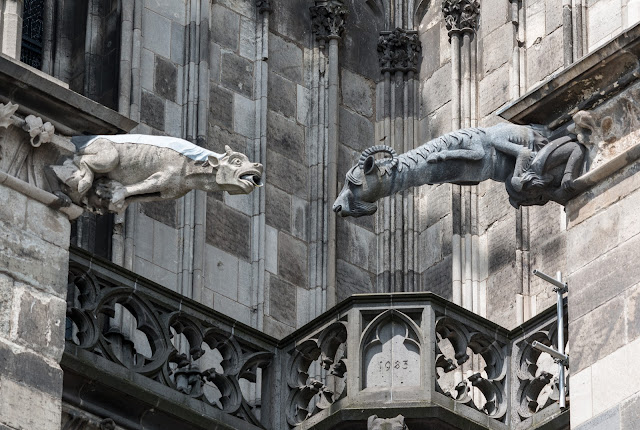Gargoyles And Their Kin
 |
| Köln | Hohe Domkirche St. Petrus |
Gargoyles and grotesques are carved figures and faces that are found on churches and other structures. The term gargoyle is often used to refer to both gargoyles and grotesques.
- A gargoyle is a decorated waterspout that extends from a roof and directs rainfall away from a building's walls, protecting them from harm. The name comes from the Old French word gargouille, meaning ‘throat’.
- A grotesque is a decorative carving with no drainage function.
The great age for gargoyle and grotesques was really the later-medieval period, the later Gothic. - cf. Alex Woodcock, cathedral stonemason and author of Gargoyles and Grotesques (Bloomsbury).
There is no shortage of humour among designers and carvers.
 |
| Tony Blair? |
 |
| Washington Cathedral | The Reverend Vader presides. |
 |
| Canadian Parliament |
A legend arose around St. Romanus (7th Century AD), the former chancellor of the Merovingian king Clotaire II who was made bishop of Rouen, and recounts how he saved the land around Rouen from a monster known as the Gargouille or Goji. La Gargouille is claimed to have had bat-like wings, a long neck, and the capacity to breathe fire. There are differing versions of the story. St. Romanus tamed the creature with a crucifix, or he captured the creature with the help of a single volunteer, a condemned man. The monster is led back to Rouen and burned in each account, but its head and neck do not burn because they are tempered by its own fiery breath. The head was hung on the freshly erected church to ward off evil spirits and serve as a protective shield. In honour of St. Romain, the Archbishops of Rouen were given the authority to release a prisoner on the day the saint's reliquary was brought in procession.
Before the use of gargoyles as rain spouts became popular in the 12th century, St. Bernard of Clairvaux was notable for speaking out against gargoyles carved on the walls of his monastery's cloister:
What are these fantastic monsters doing in the cloisters before the eyes of the brothers as they read? What is the meaning of these unclean monkeys, these strange, savage lions and monsters? To what purpose are here placed these creatures, half beast, half man or these spotted tigers? I see several bodies with one head and several heads with one body. Here is a quadruped with a serpent's head; there a fish with a quadruped's head; then again an animal: half horse, half goat... Surely, if we do not blush for such absurdities, we should at least regret what we have spent on them. - Apologia ad Guillelmum abbatem. Tractatus et opuscula. S. Bernardi Opera. Vol. III.
Lester Burbank Bridaham writes in Gargoyles, Chimeres, and the Grotesque in French Gothic Sculpture, "There is much symbolism in the sculpture of the Gothic period; but we must be wary of reading in too much meaning."




.jpg)





Comments
Post a Comment
Your comments will be appreciated and posted if 1) they are on topic and 2) preserve decorum.
Stand by your word.